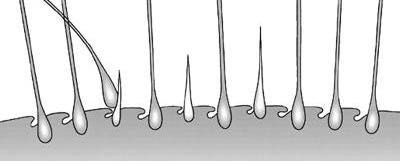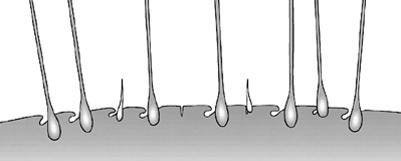Our hair and the fall: like the leaves, it too falls! But is it normal?
Collaboration : le Centre Clauderer, St-Honoré, Paris
As it is the case with dead leaves, this start-of-season “fall” comes back each year, between the end of August and the end of November. It lasts no longer than 4 to 6 weeks but it’s just enough to affect our morale, along with colder weather and back-to-school time.
For some, this seasonal hair loss goes unnoticed. For others it can lead to a loss of hair that is 3 to 4 times more significant than during the rest of the year…
What triggers it?
During spring and summer the sun’s rays heighten the level of hormonal secretions regulating hair growth, causing a reaction similar to that in plants: accelerated growth during the warm months, followed by increased loss come fall – letting go of hairs having reached the end of their life cycle.
Nothing to worry about though... After a few weeks, all falls back into place: hair loss gradually slows down and finally returns to its normal rate.
The question now is, must we treat or patiently wait for the storm to pass? All depends on the current state of your locks. If you find that your hair is already on a path of diminishing fullness, it becomes essential to follow a “support treatment”. It is actually best to begin such treatments before fully entering the hair-loss stage.
The “fall loss” test
You can do it yourself… before shampooing, on hair that hasn’t been washed in at least 3 days.
With fingers spread out, rest your hand flat, directly on the scalp. Bring fingers back together tightly and slide them along your hair, pulling hairs from root to tip. Place the hairs you’ve collected on a piece of paper and repeat the gesture at least five times – enough times to cover your whole head.
The result. If you’ve collected, in total…
Less than 10 hairs:
All is well and your hair loss is perfectly normal for now.
Between 10 and 15 hairs:
It is likely you are entering your seasonal hair loss phase. Starting right away, begin taking an oral course of vitamins for hair.
More than 15 hairs:
You have already entered and settled into the hair loss phase. A topical treatment will be needed in addition to the oral vitamins.
How do treatments help?
Capillary treatments don’t act on hair loss itself (falling hairs have already been dead for weeks) but rather on new growths. The goal is to make them as numerous and, more importantly, as strong as the hairs that came before them. It’s about nursing the next generation, if you will. There are indeed cases in which this regular fall loss is not as innocent as it should be. Without an outside helping hand some hairs can grow back finer and finer, rendering tresses thinner and harder to style as years go by.
What an expert can see under his microscope after fall loss:

Healthy scalp: here, the ten capillary follicles are occupied. 7 are by adult hairs, 2 by re-growths, 1 by a hair about to fall out with re-growth already present.

Deficient scalp: here, looking at 10 capillary follicles we see that:
- one is dormant and ready to disappear
- 2 are occupied by re-growths that are too weak
Another important element: duration. Normal seasonal loss shouldn’t last more than 4 weeks (6 weeks maximum). Persisting hair loss means another factor is the cause and it becomes important to find out what that is.



| Spas | Care & Make-up | Health | For Men | Glossaries | Various | |||||
| Intro | Face (care) Make-up Body Hair Endless Youth Mother & Baby Corner Suncare Essentials And more... New products Spot A HairdresserMake-up Artist Directory | Healthy Diet Watching your figure Relaxation | Intro New products | All about... | Phytotherapy All Natural Fashion Perfume Jewelry & accessories And more... What is your style? |
-

 Spas
Spas
-

 Care & Make-up
Care & Make-up
-

 Health
Health
-

 For Men
For Men
-

 Glossaries
Glossaries
-

 Various
Various








